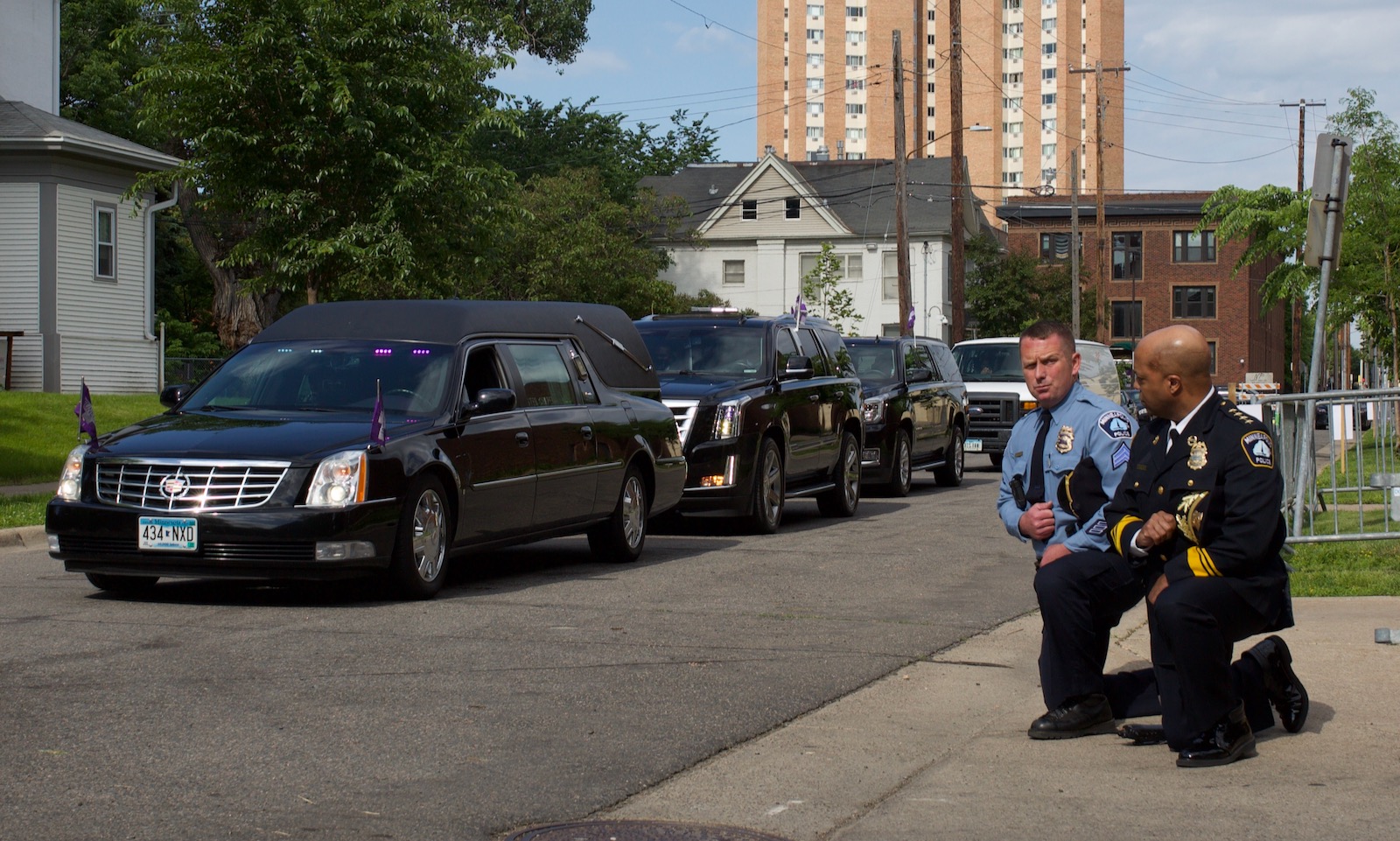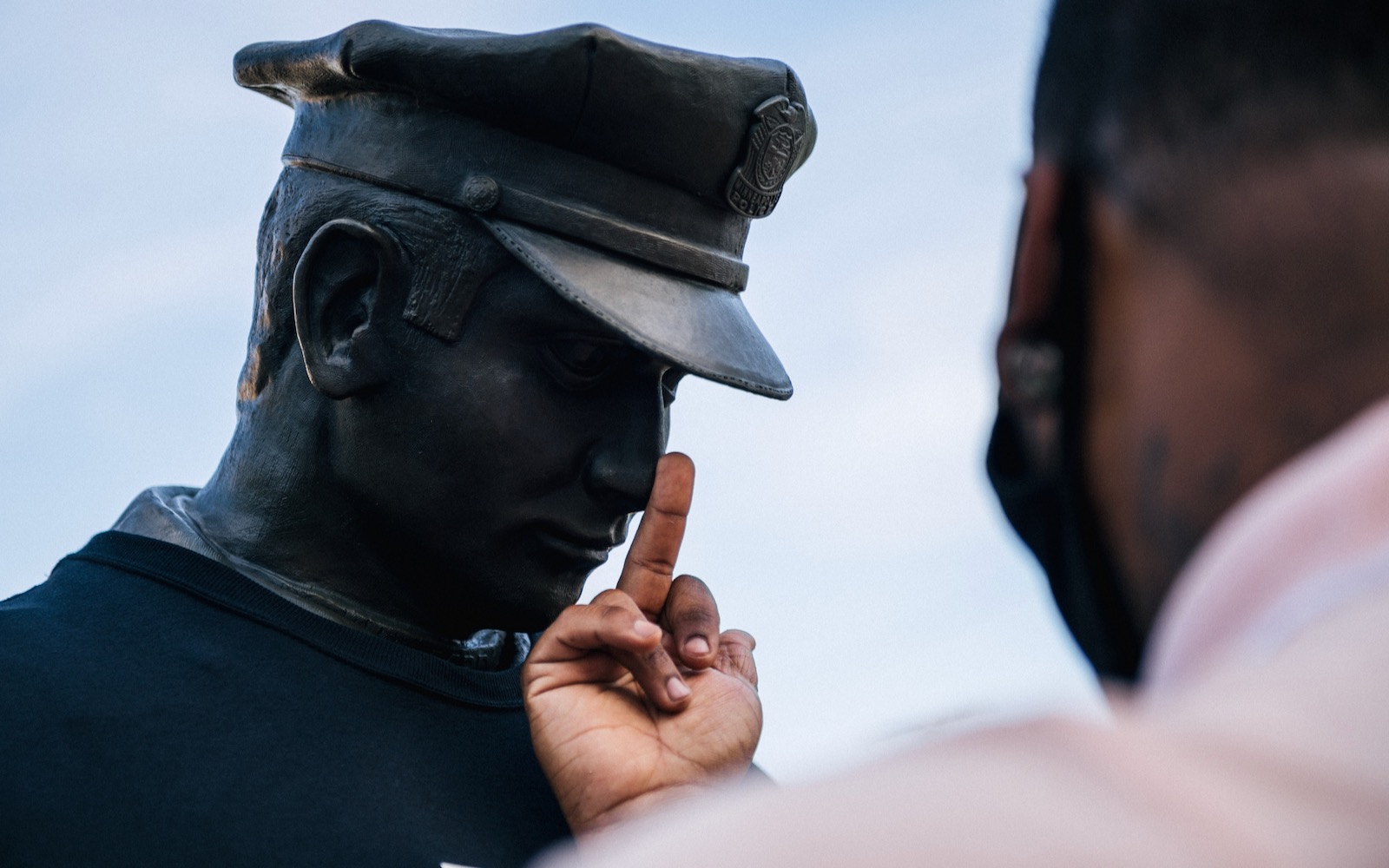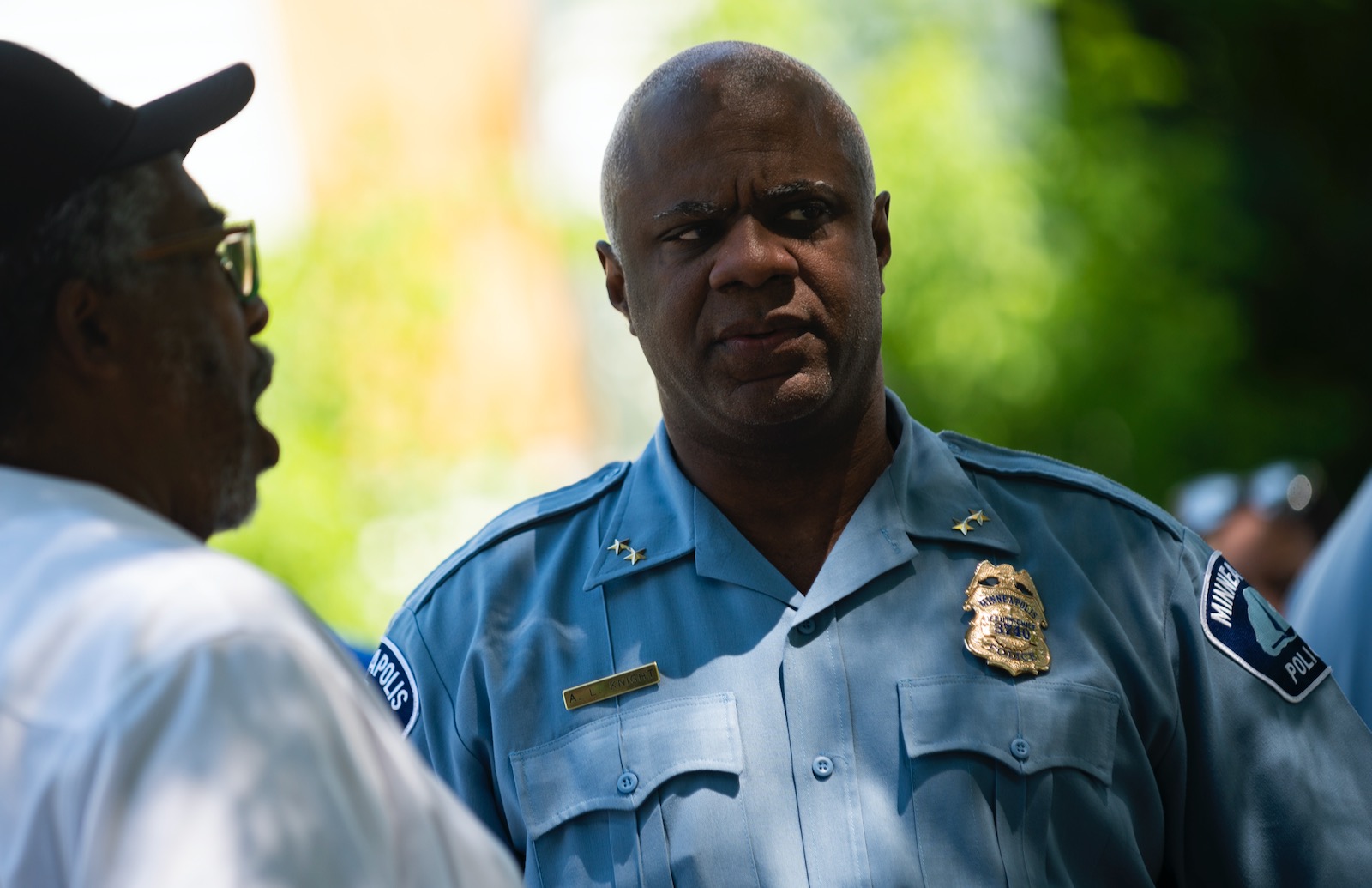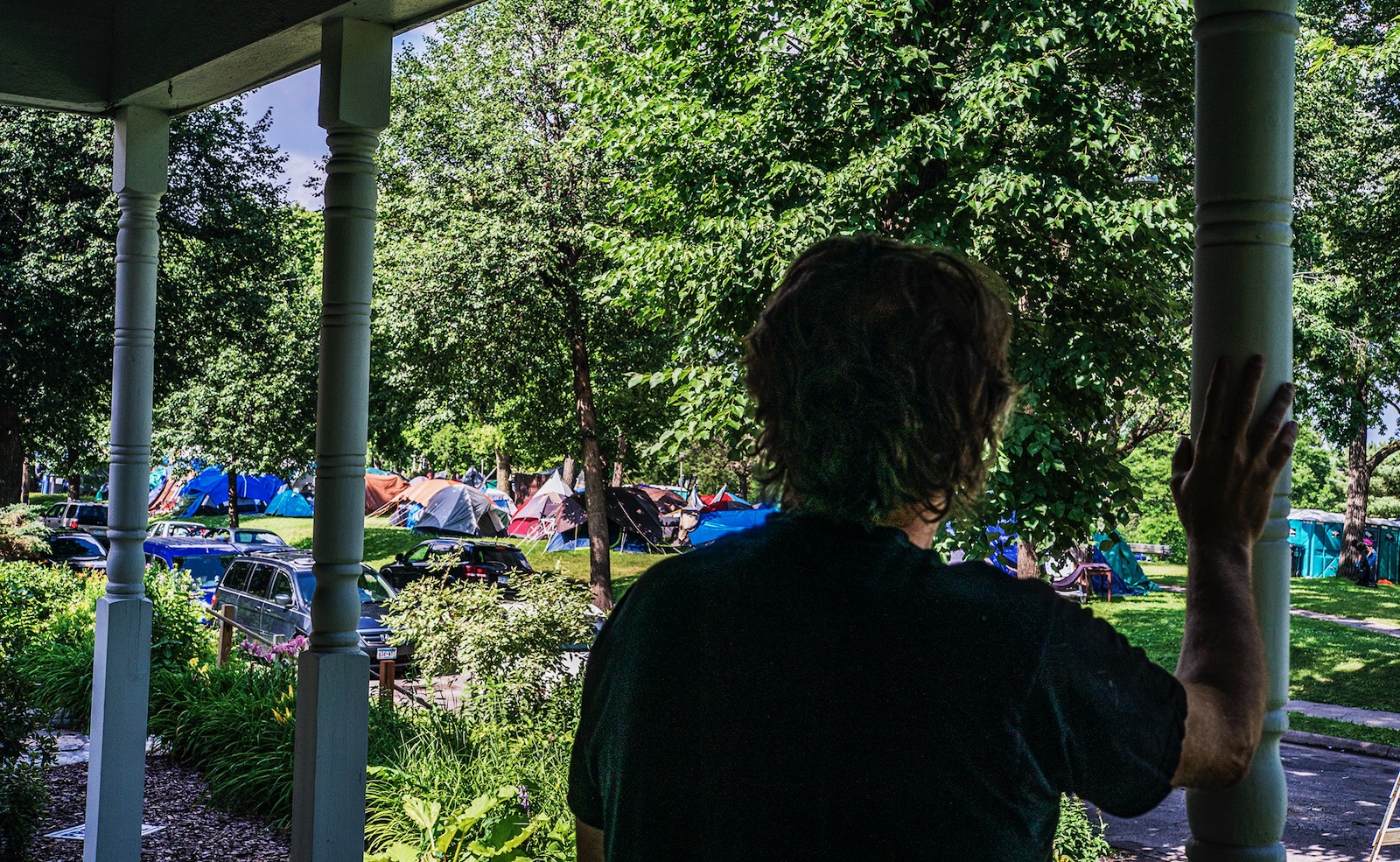Minneapolis, Minnesota—To begin, two tales of Twin Cities police.
First, Donn Landrum. The fifty-three-year-old served three foreign tours in the Navy, discharged right before the Gulf War. Thanks to his military experience, he quickly found work in private security after that. Landrum, who is black, grew up in Chicago—and still wears a Bulls jersey—but has lived in Minneapolis since 1987. While working, he eventually went back to school and obtained a bachelor’s degree so that he could enroll in the city’s police academy, which he did in 2008.
He quit within six weeks. “The disparities in how they treated black people were just too big,” he told me. “It was my deep feeling that it couldn’t be changed.”
He returned to the private sector, working for various security firms over the years. One of his colleagues in 2017 was George Floyd. “A really nice guy,” he recalled. “Never started anything.” Landrum attended Floyd’s funeral last month.
Second, Clarence Castile. He is the uncle of Philando, who was infamously murdered by police in 2016 in Falcon Heights, a suburb of St. Paul. The sixty-year-old works as a landscaper, but at the time of his nephew’s death, he was well on his way to his certification as a reserve police officer in St. Paul. He went ahead and completed it, and took up a volunteer post that requires a hundred hours of service per year, usually to assist in tasks like traffic control for public events. Today, Castile wears the same blue uniform as regular cops, but does not carry a firearm.
“I had a moment of reflection when that happened, for sure, when I didn’t think I could go through with it,” he told me. “We saw seven bullets get emptied into his [Philando’s] body. I was so angry; I hated cops. But it wasn’t all cops who killed my nephew… I had friends from high school who became cops and they cried with me, in their uniforms,” he went on. “My family doesn’t hate cops. If we turn angry and stay angry, all it would do is fuel other people’s anger.”
Those two accounts go to the heart of a raging debate in Minneapolis over whether to reform or abolish the city’s police department in the wake of the protests over George Floyd’s murder that have shaken the nation, and the world beyond. When nine members of the City Council stood together in a park on Sunday June 7, a fortnight after Floyd’s killing, and announced their intent to “disband” the department, it seemed like an astonishing victory for the popular uprising. The council members stated simply that “The Minneapolis Police Department cannot be reformed and will never be accountable for its actions.” Even after the heat of that moment, every single member of the council voted on June 27 to advance a proposal to create a new department of Community Safety and Violence Prevention, to be led by someone with “non-law enforcement experience.”
To the generation of activists shaped by Black Lives Matter, this sequence of events seems to offer an unprecedented chance to completely redefine policing, and they are pinning their hopes on the charter amendment, in spite of state-level gridlock on other police reforms. But to other activist groups that have been through previous cycles of campaigning, setbacks, and disillusionment, the potential for such dramatic change appears dimmer.
“We are definitely moving in the right direction,” said Kandace Montgomery, a queer black organizer who in 2018 co-founded the group Reclaim the Block, a leading voice on the abolitionist side. “What we’re focused on now is that people get an opportunity to vote for an amendment to the city charter addressing the abolition of the police department, and getting it on the ballot in November,” she said. The deadline for adding new items to the ballot before this year’s election day is August 21. Under consideration is the very existence of a city police department, as well as the required minimum number of police for the city’s population (currently set at 730 officers).
Reclaim the Block activists have helped pro-abolition councilmembers formulate language for this amendment, a dialogue that Montgomery said would have been impossible until very recently. “Engagement was very minimal before Floyd’s murder,” she said. “Having people out on the streets every day has been key to getting them to pay attention. If we’re not pressuring them, they are going to lose focus.” Just last year, she noted, the council authorized an $8 million increase to the police department’s budget. Even this amendment is subject first to revision by a fifteen-person volunteer commission, and second, to a vote in the council on whether that wording gets put up for referendum in November. And even if that passes, it would still have to go to the mayor for his approval (though the council could override his veto).
Advertisement
One reason for the abolitionist camp’s confidence is that it is articulating positions that have gestated for several years. A landmark report by regional activists called “MPD150” presented a well-researched “practical pathway for the dismantling of the Minneapolis Police Department” back in 2017. And the grassroots groups Reclaim the Block and the Black Visions Collective have heavily foregrounded abolition, in addition to demanding specific budget cuts to the police, most recently calling for a $45 million decrease.
“It’s basically been six years of political development on the police abolition front,” said Philip V. McHarris, a scholar and organizer. “People have had the opportunity to learn, build, and grow with one another in the context of a broader movement since the Ferguson era,” he said. “The movement became an ideological incubator.” As an organizer in New York, he recalls discussing cop-free zones in Chicago as an alternative to policing, typifying the “real sharing of ideas” that took place in this period across state lines.
In the early response to the movement, he noted, under the Obama administration, the focus was on technocratic solutions like body cameras. But today’s renewed calls for abolition and structural change draw on deeper intellectual roots, like the work of Angela Davis, Ruth Wilson Gilmore, Mariame Kaba, and Alex Vitale. More recently, the Movement for Black Lives, the umbrella activist organization that arose in 2014, also developed the policy ideas of investing in social services and divesting from policing that informs abolitionist demands today.
Still, even in its newly robust form, abolition does not draw a universal consensus among campaigners in Minneapolis, some of whom remain committed reformists. Michelle Gross, who leads the nonprofit Communities United Against Police Brutality, has called the charter amendment “totally flawed” and has criticized the process behind the proposal as rushed.
Her organization was chastened by events two years ago, when the City Council failed to act on popular, more modest demands to reform the police department after a black man named Thurman Blevins was fatally shot by a cop in 2018 and no one was charged. The City Council floated a proposal for it to oversee the police instead of the mayor, but it didn’t get off the ground. Gross’s group complains that the city authorities seemed to learn nothing from that experience.
Then, just nine months before Floyd’s murder, a coalition including CUAPB issued fourteen proposed changes to the contract between the police department and the city. Their proposals were fairly wonky—such as calling for officers to be penalized for bad behavior through a new “disciplinary matrix” of measures—and the major priorities were far from radical, including items such as capping officers’ work hours to limit fatigue and making mental health screenings mandatory. In March, the coalition revealed that its members had been shut out of City Council discussions, an exclusion that only intensified as the pandemic and lockdown took hold.
Acknowledging such setbacks, Sheila Nezhad, another Reclaim the Block organizer, admitted during a recent webinar that if the council stalled past the August deadline, activists would have to gear up for at least another year of pressure. For its part, CUAPB argues that its more modest slate of reforms could usefully be adopted as interim measures, whether or not the charter amendment moves forward.
While the council famously had a “veto-proof majority” of nine when it announced its commitment to dismantle the police, Mayor Jacob Frey has dismissed proposals to rewrite the charter and rejected the concept of defunding the police in general. But a recent national poll from The Washington Post found that 69 percent of respondents believed that “Floyd’s killing represents a broader problem in law enforcement,” as opposed to 43 percent who did so in 2014 after the Ferguson protests. Frey may be swimming against the tide of public opinion.
*
The Minneapolis Police Department dates back to 1867. By the 1920s, when the city was still about 99 percent white, the force was shot through with Ku Klux Klan members and sympathizers. In June 1922, officers made several high-profile arrests of black men for “disorderly conduct,” which provoked the city’s small black community to protest, and for the local chapter of the NAACP to meet with the Mayor. Its major demand: increasing the number of black people on the force.
A century later, that refrain—“We need more cops who look like us”—was one I heard today all over the Twin Cities, and notably from many different black men, including John Thompson, the friend of Philando Castile who is now running for state office in a House district of St. Paul; Deputy Police Chief Art Knight; and community activist Jamar Nelson, who helps lead a group called A Mother’s Love that cooperates with the police department over community patrols. It’s true that the demographics of the city’s police force is still not representative. In 2015, 22 percent of the Minneapolis police force and 17 percent of the one in St. Paul was nonwhite, compared to 40 percent and 46 percent nonwhite presence in their respective populations.
Advertisement
The Minneapolis Police Department’s recently appointed chief, Medaria Arradondo, is the first black person to hold the office; Art Knight is a deputy chief serving under him. In 2007, Arradondo and four others sued their own department, alleging that black officers were disciplined “more harshly and frequently” than their white counterparts for comparable misconduct; the suit was settled out of court. In their complaint, the black officers said that some of them had received hate mail signed “KKK.”
“I’ve been a policeman for twenty-eight years, but my first perspective of the world is being black,” said Knight. Originally from Chicago, he is an avowed fan of Barack Obama’s initiatives following Trayvon Martin’s murder and has been credited with introducing to the Minneapolis police several typical post-Ferguson reforms such as body cameras and implicit bias training. Today, he remains a committed incrementalist, though he is obliged to admit that the training he has championed is not a panacea: “The frustrating thing about Derek Chauvin [the cop who killed Floyd]—and I was even his supervisor for six months, though I don’t remember much, because he was unremarkable, honestly—was that he did go through all these trainings. And it still didn’t make a difference.”
“We have a joke in policing, that cops hate two things: change and the way things are,” he told me. When Knight joined the force in 1992, shortly after the Rodney King riots in LA, he was one of only two black officers in the whole department. “So from my perspective, the changes since then have been substantial. We certainly never talked about something like ‘bias’ when I was in training.” He has fired a gun twice in his career, neither occasion resulting in a fatality.
His “number one priority” when he was appointed as deputy chief in 2017 was improving the force’s diversity, which he labeled “atrocious.” “But diversity doesn’t come for free,” he said; one of the main means to recruit nonwhite officers is a cadet program for people who didn’t major in law enforcement in college (which is a requirement for the MPD). Knight estimated that it costs about $250,000 a year in total, which has made the department reluctant to keep funding it.
A more representative police force seems like a good idea, but would more black cops actually result in fewer police-involved killings? In the influential 2017 monograph The End of Policing, Alex Vitale surveys the literature and concludes that “There is now a large body of evidence measuring whether the race of individual officers affects their use of force. Most studies show no effect.” Despite modest increases in the nonwhite police numbers since Knight started his career there, the Minneapolis force still heavily over-polices black people, who are about nine times more likely than white people to be arrested for low-level offenses like trespassing, disorderly conduct, and loitering, according to an ACLU report from 2015.
If abolition becomes the order of the day, it will doubtless make all these efforts at internal reform look quaint, if not feeble. But whether abolitionist or reformist, all efforts to overhaul the MPD face one formidable foe: the extremely strong police union, led by the pugnacious Bob Kroll, a lieutenant who has described the Floyd protests as a “terrorist movement.” If the police department is not dismantled, the union will be the main roadblock to reform. Pete Gamades, an organizer with the group MPLS for a Better Contract, argues that changes to the contract are possible. Pay, he said, has been “used successfully for leverage against police unions in cities like Austin. Off-duty work can be very lucrative for police, so it’s in their best interest to agree to work fewer hours.” But, he also acknowledged, “We look at this as an addition to, not an alternative to, the charter debate.”
Prospects for using this leverage, though, look limited. The union negotiates directly with the mayor, not the City Council, and had already, before the pandemic, moved its current contract talks to a “mediation” stage, which prevents further public involvement. Since Floyd’s death, Police Chief Arradondo has pulled out of negotiations altogether—indicating that he does not see the contract as a vehicle for change.
*
In face of this stop-start nature of institutional change, some in Minneapolis are taking the job of public safety into their own hands. Powderhorn Park, in south-central Minneapolis, is a leafy, residential neighborhood just a few blocks from Cup Foods, where Floyd was murdered. In early June, the park itself became the site of pop-up settlements in camping tents of unhoused people, who now number over eight hundred. These started on June 9, when about two hundred homeless people who’d occupied the Sheraton Hotel in the aftermath of the Floyd protests were evicted. Because of this and the park’s proximity to the site of Floyd’s murder, anti-police sentiment runs high in Powderhorn.
“This is essentially a no-go zone for the police,” said Jack Nobles, a middle-aged white man who usually works as a set designer. He has become one of dozens of volunteers who have been staffing these camps around the clock to provide food and water, medic tents, showers, even weekly laundry.
Dennis Barrow, who is now in his fourth month without formal housing, is one of the “day one” encampment residents, and does double-duty as a community security guard. “We know who’s who,” he said, “we police our own community.” He wore a whistle around his neck on a lanyard that said “SMILE.” “We don’t use firearms at all,” he said. “The key thing is de-escalation.” To him, this means conversations, direct engagement, and being a familiar face. The Powderhorn Park security team, which numbers about a dozen, report to an exacting commander named Dee, who wears a white durag and has a habit of picking up garbage behind the other residents. There is a noise curfew starting at 10 PM, and community meetings every evening at 7 PM.
But the informal settlement’s experiment has had its challenges. At least three sexual assaults have been reported there, and gun violence is on the rise, too. When I visited one morning this month, Nobles said there had been a spike in meth use when people got their unemployment checks. “I’m a former addict, so I can tell,” he said. “We officially take a harm reduction approach here and provide clean needles, have people trained to administer Narcan [a nasal spray that can treat opioid overdoses], and so on—but we don’t, as a rule, ever want to call 911 about an overdose because that will end up on the police scanners.”
In the immediate aftermath of Floyd’s murder, when the neighborhood was a hot zone for violent riots, local residents started to organize their own community patrol, too. Danielle Enblom, a dancer who has been living in an apartment near the park since March, became a leader of the neighborhood watch program in May. “We had one big meeting in the park where almost a thousand people attended,” she told me, “and we discussed how to keep ourselves safe in the absence of policing—or even from the police.” Her group now counts 120 active members who communicate on a mobile group chat and maintain a neighborhood watch in a four-to-five block radius. The initial impetus for security waned somewhat after the most violent phase of the protests, but the unhoused encampment in the park filled its place, to an extent. Like many of her neighbors, Enblom was happy to support the sanctuary movement there, but “there are a lot of fears and concerns, which is understandable,” she said. “Look, the neighborhood is not going to be as safe and secure as it once felt.”
Already, it seems as though time may be running out for the Powderhorn sanctuary, and the utopian window into a different world, where goods and services were freely circulated within a city to its most vulnerable, may be closing. Signs at the park now broadcast “limited resources” and a “new volunteer model,” and there is a de facto moratorium on new tents; volunteers have been peeling off because of perceived security risks and armed robberies during daylight hours. The ones who have stuck it out, with the idea that community-led safety should not be given up even under such circumstances, are grittier, and employ guerrilla tactics.
Nomad, the alias of a twenty-four-year-old volunteer with an ad hoc security group called Bikwakoon (an Ojibwe word for a bundle of arrows), is one of them. He says he hasn’t slept much since Memorial Day, spending all night, after his shifts as a line cook, zipping to high-risk neighborhoods on his motorbike, with a bandana tied around his face. “There’s no strict protocol, and we don’t use firearms, but our MO is really just to deescalate situations verbally and get people help without calling the police,” he said, of Bikwakoon’s approach. Their approximately twenty-five members coordinate through the Signal messaging app and deploy to wherever they’re needed, from about 10 PM to 4 AM each night.
Last week, they were patrolling at Little Earth, an affordable housing complex home to many Native Americans, when they encountered a teenaged girl who had overdosed with opioids and started foaming at the mouth. Nomad helped rouse her to consciousness and called an ambulance, waiting with her family until they came, and politely refusing police intervention. On Friday night, another volunteer who goes by the name No Face conveyed a young woman who had been sexually harassed at Powderhorn to another, smaller encampment in his white cargo van. A central assertion of the police abolitionists is that many of the things people call 911 for could be answered by people without guns: “mental health professionals, social workers, domestic violence advocates, and other responders,” per the “MPD150” report.
For the time being, these community-led policing initiatives have proliferated, often taking over from the MPD effective responsibility for public safety in their localities. Another group along these lines, formed in the wake of the Floyd uprising, are the Freedom Riders, an armed group of about fifty volunteers originally assembled by the Minneapolis NAACP to protect black-owned businesses during the riots. Yet another group, led by black female organizer Alicia Smith, known as the Minnesota Safe Streets Coalition is based in the Corcoran neighborhood and in Little Earth, an all-night patrol organized by Native American residents call themselves “the protectors.”
But how sustainable in the long run is it for autonomous, volunteer groups to provide community policing—given the strenuous, high-stakes, all-night demand for security in the face of real social problems? “I think we’re pushing for our elected officials to step up and show up and come to the table with solutions with us at this point,” said Enblom, who volunteers occasionally at the Powderhorn sanctuary beyond coordinating her neighborhood watch. “It shouldn’t be the job of unpaid neighborhood volunteers to make it work.”
Meanwhile, three of the councilmembers who support defunding the police had received a barrage of threats, and, for most of the month of June, the City had to assign them a private security detail, rather than MPD officers. The cost, it was revealed this week, was over $150,000.
This article is the second in a three-part series supported by the Economic Hardship Reporting Project.





